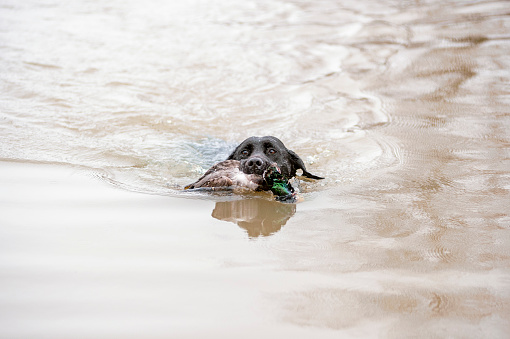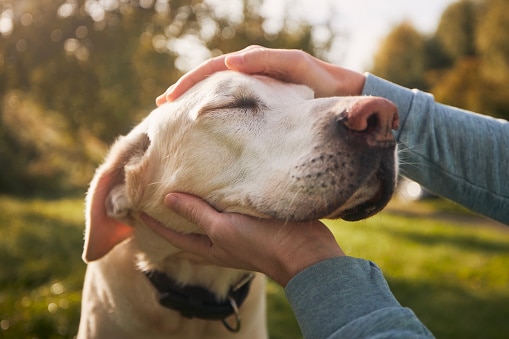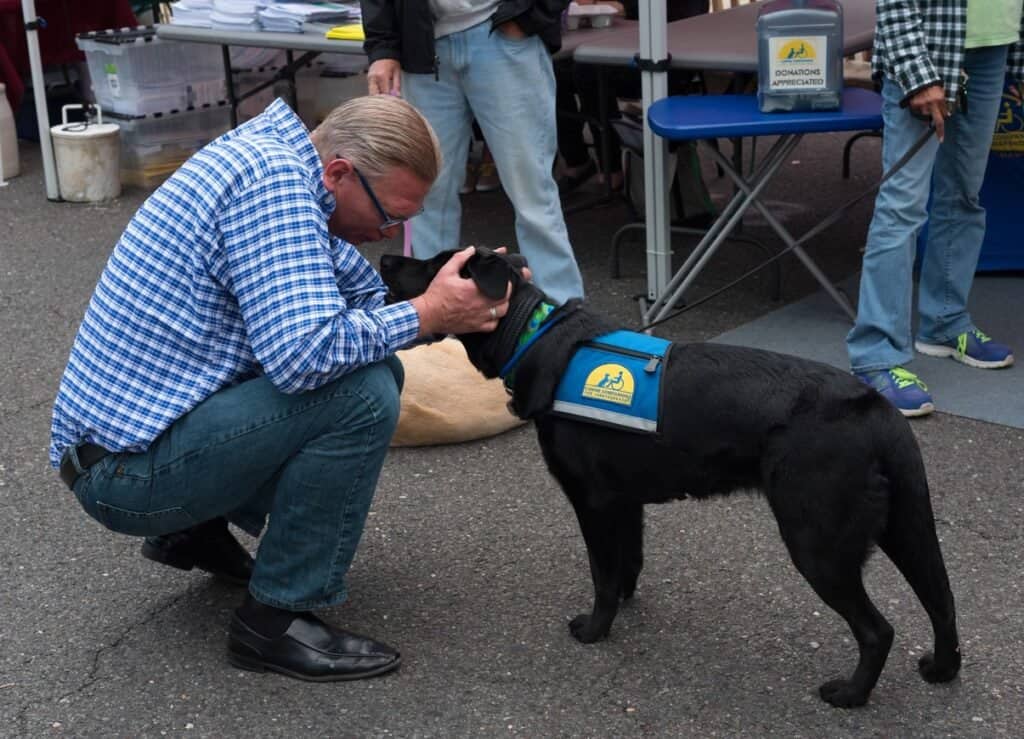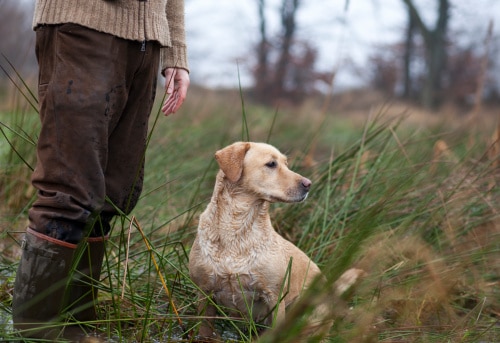
Labrador retrievers have brains and brawn. However, they’re most well-known for their big hearts. Look a lab in the eyes and try not to fall in love. It’s pretty much impossible. These friendly dogs also have some of the best senses and thinking skills. They even have a unique history and all sorts of silly quirks. Read on to learn 10 incredible labrador retriever facts.
1. Labrador Retrievers Are America’s Favorite Breed

Labrador retrievers rank number one on many canine registries in the United States.
©4 PM production/Shutterstock.com
First, on our list of incredible labrador retriever facts, let’s talk about favoritism. Labrador retrievers rank number one on tons of canine registries in the United States. It’s hard to narrow down one specific reason labs are so well-loved. However, it’s easy to say that these are a versatile breed.
Labs make lovely hunting dogs, family pets, and companions. They can also be a fun source of entertainment since they’re always willing to play! Families with young children in the house will love how labs and kids play together. The bond between a lab and a child can be inseparable.
2. They Have Incredible Memories

Hunting Labradors have to remember where the ducks go down in the water before retrieving.
©Anna Pozzi/ via Getty Images
While humans might forget where they put the keys, a labrador remembers everything! They have incredible memories, which makes sense because they were bred for their ability to remember. This trait is beneficial when they’re on the hunt.
Every bird that falls the labrador can keep track of. Their highly tuned memories give labs the advantage of remembering training skills faster than other breeds. A lab can remember countless commands if they have regular brush-up sessions. Labradors remember training better if they play after each session; it’s called post-training playfulness.
3. There Are 3 Labrador Colors

Labrador retrievers come in yellow, black, and chocolate.
©iStock.com/lizcen
Hunting labrador retrievers come in 3 colors– yellow, chocolate, and black. The number of black labs in a litter usually outnumbers the yellow ones. Alternatively, there are usually more yellow labs than there are chocolate ones.
Some color phases of the yellow lab can make them appear to be red, but it’s rare. In comparison, if you think you’re looking at a white lab, it’s a yellow lab in disguise. A yellow lab with an exceptionally light coat may look all white, even though they aren’t. Finally, there are also silver labradors, but they don’t qualify as purebred labs.
4. Labradors Have Webbed Feet

Unlike other dogs – Labs have webbing between their toes for easier swimming.
©Olena Babak/ via Getty Images
When you think of webbed feet, you probably think of a duck. However, labrador retrievers have webbing between their toes too! The entire physical structure of a labrador is designed to be in the water. The webbing between their toes helps labradors swim quickly and efficiently. They have a water-repellent coat, and their tail works as the perfect rudder.
Not only are they good at swimming, but labs love the water! If you let them, your labrador would spend hours swimming back and forth. However, it’s best to give them breaks. Experts recommend giving your lab a break after 30 minutes of swimming. If you notice they’re getting worn out, you might need to give them a break sooner.
5. They’re One of the Smartest Breeds

Labrador retrievers rank fourth on the canine intelligence testing scale.
©Pavel Hlystov/Shutterstock.com
If a labrador ever outsmarts you, don’t feel bad. They rank fourth on the canine intelligence testing scale. Their brilliant nature can get them into trouble sometimes. If left to their own devices, a lab could easily spend their day hiding your socks and finding all the bits of trash you didn’t know existed! Wearing them out is one of the best ways to keep a creative labrador out of trouble. Especially when they’re puppies, labs require a lot of exercises. Their favorite games include fetch, tug of war, and frisbee!
6. Labradors Are Bad Guard Dogs

Labrador retrievers are so kind and friendly that they make terrible watchdogs.
©Chalabala/ via Getty Images
Next on our list of incredible retriever facts, most labs aren’t good attack dogs. Labs are protective of their owners. However, they have a kind and friendly temperament. They’re so kind that they make pretty horrible guard dogs. While they might bark and fuss if something isn’t right, they’re not likely to attack. Alternatively, their kind demeanor makes them the perfect choice for hunters and showring competitors. Labs are comfortable and happy to be around other animals, especially dogs.
7. They’re Active Members of the Community

Labrador retrievers make great service dogs.
©iStock.com/jfbenning
There are tons of different ways that labrador retrievers serve society. Some labs work as search and rescue dogs, while others specialize in bomb detection. There are also labrador retrievers who are therapy dogs, guide dogs, drug and arson detection dogs, and assistance dogs. Their keen senses and ease of trainability make them the perfect fit for all sorts of jobs.
8. Labrador Retrievers Can Weigh Over 100 Pounds

Labs range in size by quite a bit and can gain too much weight if they aren’t exercised.
©Chalabala/ via Getty Images
Labrador sizes range quite a bit. A labrador retriever can be anywhere from 50 lb to 100 lbs or more! Males tend to weigh more than females. An adult male labrador will usually weigh somewhere between 65 to 80 lb. Alternatively, a fully grown female labrador usually weighs 55 and 70 lb.
They also have a decent height. Male labs tend to have a height of between 22.5 inches to 24 inches. Female labs have a height between 21.5 inches and 23.5 inches. Overall, labradors are strongly built and are bred to be athletic.
9. English Anglers Were the First Labrador Owners

Labrador retrievers were developed by English fishermen working in the waters of Newfoundland.
©manushot/ via Getty Images
The first labrador retriever was registered with the Kennel Club in 1903. However, the first labrador registered with the American Kennel Club in the United States wasn’t until the 1920s.
The origin of the labrador retrievers starts in the British Isles. Historians believe that English anglers developed the labrador when working on the waters of Newfoundland. The eager-to-please labs helped make a long day of fishing go by quickly! The labradors would help retrieve fish caught in nets and even the nets themselves.
10. Labrador Retrievers Don’t Hunt Independently

Unlike other hunting breeds, labradors watch for their hunter’s signal before retrieving game.
©juliazara/ via Getty Images
Last, on our list of incredible labrador retriever facts, labs don’t naturally hunt. Certain dog breeds, like pointing breeds and hounds, can hunt semi-independently from their handlers. However, a labrador relies on its person. Even if a lab wants to retrieve a downed waterfowl or game bird, it won’t do so until the sportsman tells them to. This is due to labradors’ tight historical and genetic bonds with humans.
If you’ve ever felt the warmth of a devoted lab against your leg, you understand what we’re talking about. The labrador lean is just one of the many signs that the bond between labs and humans is complete and lifelong.
What else is there to learn about labs and other dog breeds? Try taking a dog-themed quiz to learn more and to test your dog knowledge!
The photo featured at the top of this post is © iStock.com/sanjagrujic
Ready to discover the top 10 cutest dog breeds in the entire world?
How about the fastest dogs, the largest dogs and those that are -- quite frankly -- just the kindest dogs on the planet? Each day, AZ Animals sends out lists just like this to our thousands of email subscribers. And the best part? It's FREE. Join today by entering your email below.
Thank you for reading! Have some feedback for us? Contact the AZ Animals editorial team.






